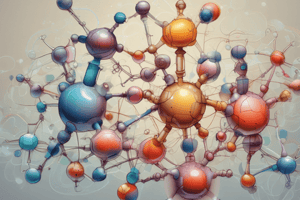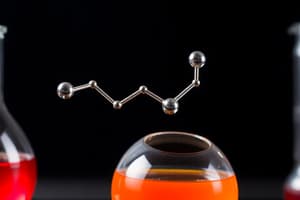Podcast
Questions and Answers
What is the primary mechanism by which primary amines react with halides to form N-alkylated products?
What is the primary mechanism by which primary amines react with halides to form N-alkylated products?
- SN1 mechanism
- SN2 mechanism (correct)
- Nucleophilic addition
- Electrophilic substitution
Which type of amines are more easily oxidized to form amine oxides?
Which type of amines are more easily oxidized to form amine oxides?
- Arylamines
- Tertiary amines (correct)
- Secondary amines
- Primary amines
What is the byproduct formed during the alkylation reaction of amines with alkyl halides?
What is the byproduct formed during the alkylation reaction of amines with alkyl halides?
- H2O
- NH3
- RCl
- HX (correct)
What is the ratio of amine to alkylating agent that can improve the reaction efficiency of alkylation?
What is the ratio of amine to alkylating agent that can improve the reaction efficiency of alkylation?
What is the reaction type that involves the formation of an amine oxide by adding an oxygen atom to the nitrogen atom?
What is the reaction type that involves the formation of an amine oxide by adding an oxygen atom to the nitrogen atom?
What is the general result of oxidation of amines?
What is the general result of oxidation of amines?
Which reagent is commonly used for the reduction of amines?
Which reagent is commonly used for the reduction of amines?
What is the product of the reaction between amines and carboxylic acids in the presence of a base?
What is the product of the reaction between amines and carboxylic acids in the presence of a base?
Which type of amines does not participate in nucleophilic substitution reactions with acid chlorides or anhydrides?
Which type of amines does not participate in nucleophilic substitution reactions with acid chlorides or anhydrides?
What is the role of the nitrogen atom in nucleophilic substitution reactions?
What is the role of the nitrogen atom in nucleophilic substitution reactions?
Flashcards are hidden until you start studying
Study Notes
Reactions of Amines
Amines, compounds containing nitrogen with a lone pair of electrons, are versatile compounds in organic chemistry. They react with various reagents to produce a range of products. This article will discuss the reactions of amines, focusing on the subtopics: alkylation, oxidation, reduction, amino acid synthesis, and nucleophilic substitution.
Alkylation
Amines react with alkyl halides to form N-alkylated products. Primary amines react with halides (RCl) through an SN2 mechanism, while secondary amines react with halides to form salts, which are then deprotonated to form alkylated products. However, the direct alkylation of 1º or 2º amines to give more substituted products does not proceed cleanly. The reaction efficiency can be improved by using a 2:1 ratio of amine to alkylating agent, as in the example:

This reaction produces HX as a byproduct, which can be neutralized by an excess of ammonia to form ammonium salts.
Oxidation
Oxidation of amines involves adding an oxygen atom to the nitrogen atom, leading to the formation of an amine oxide. Arylamines tend to be easily oxidized, with oxidation occurring on the amine group as well as in the ring. Tertiary amines are more easily oxidized than primary amines, leading to the formation of amine oxides.

Reduction
Reduction of amines involves removing oxygen atoms from the nitrogen atom, leading to the formation of amines with fewer oxygen atoms. This reaction is generally reversible, and the reduction can be carried out using various reducing agents, such as lithium aluminum hydride (LiAlH4).

Amino Acid Synthesis
Amino acids are the building blocks of proteins, and their synthesis is an essential process in organic chemistry. Amino acids can be synthesized by reacting amines with carboxylic acids, such as acetic acid, in the presence of a base, typically ammonia, to form amides. This reaction can be represented as follows:

Nucleophilic Substitution
Amines can act as both bases and nucleophiles due to the lone pair of electrons on the nitrogen atom. They can displace hydrogen atoms in a nucleophilic substitution reaction with acid chlorides and anhydrides to form amides. Primary and secondary amines react with acid chlorides or anhydrides to form amides, while tertiary amines do not participate in this reaction.

In conclusion, amines are versatile compounds that can react with various reagents to form a range of products. Understanding these reactions is crucial for applying amines in organic chemistry and developing new synthetic methods.
Studying That Suits You
Use AI to generate personalized quizzes and flashcards to suit your learning preferences.




